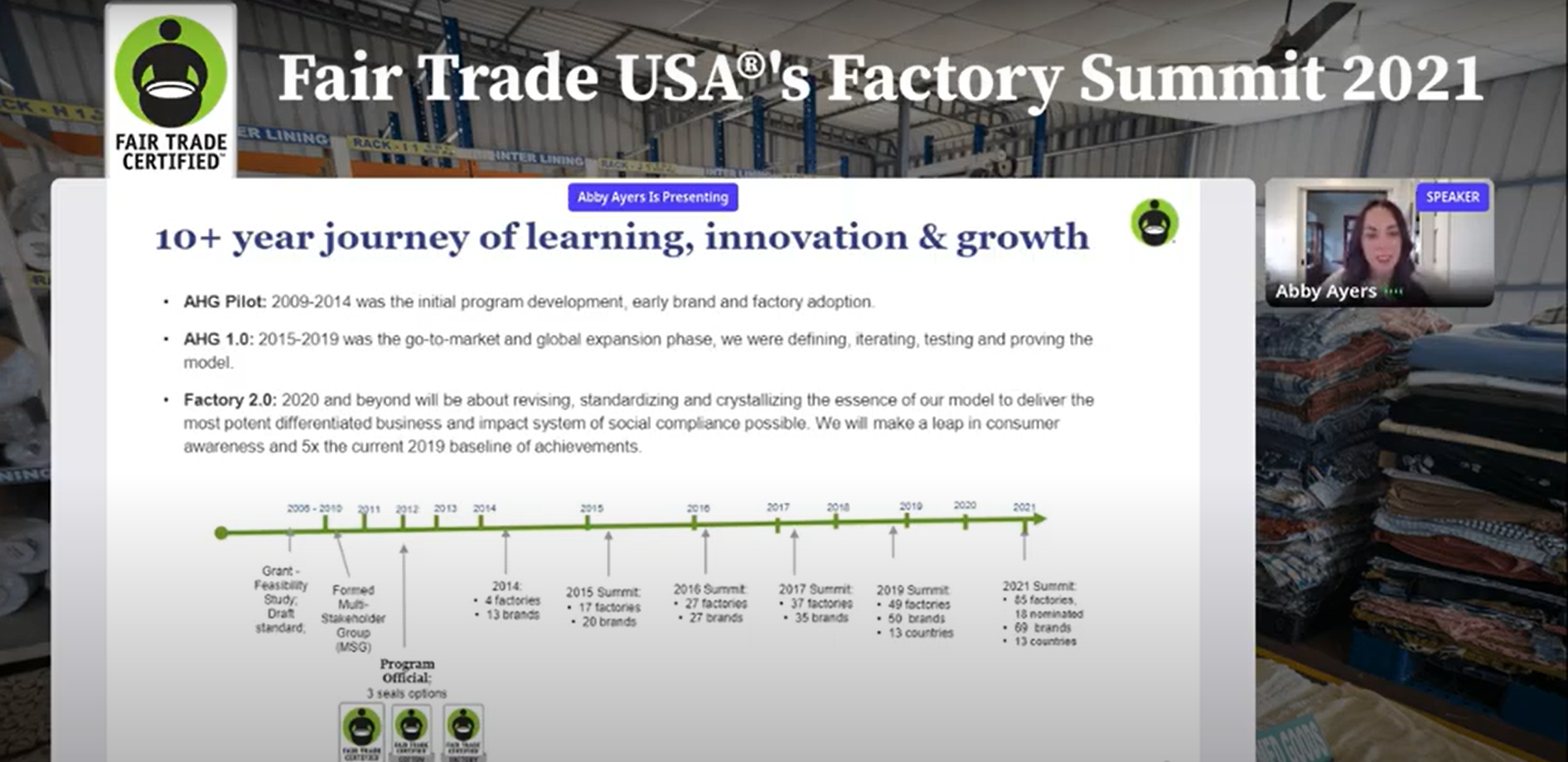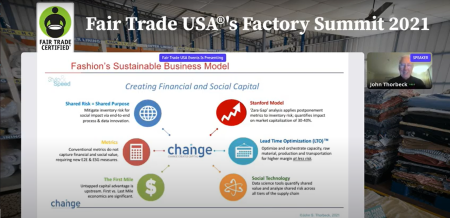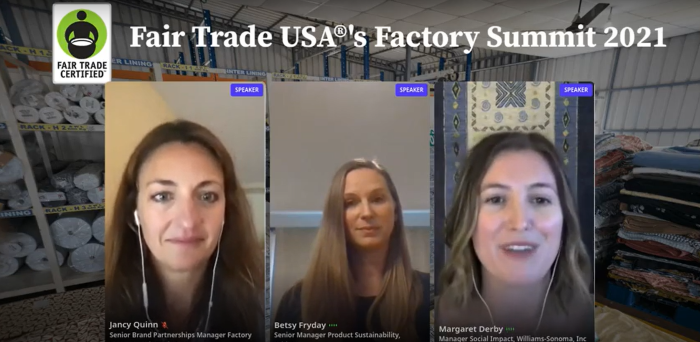This year’s virtual summit brought together sustainability champions, operational and sourcing leaders, and marketing teams from the apparel and home goods industry.
In 2010, Fair Trade USA piloted the first-of-its-kind Fair Trade Certified™ factory standard alongside early adopters like prAna and HAE Now. It’s been a journey of impact, innovation, and growth ever since. In just over a decade the program has secured sourcing commitments from over 60 brands, supported nearly 100 factories to comply with the standard, activated workforce engagement in all of them, and continues to measure long term impacts for all beneficiaries.
To assess performance and make continuous improvements, Fair Trade USA recently held a virtual, invitation-only Factory Summit. Sustainability advocates, along with leaders from the apparel and home goods industry, came together to assess current marketplace conditions, share updates about the Factory Program Redesign, and revisions to our standards, and discuss the trends that are inspiring an ever-evolving industry.
Read on to learn more about the event.
Additional Worker Support Through Two Years Of Stress and Strain
Since the COVID-19 pandemic’s onset supply chain constraints have put a spotlight on workplace conditions at factories around the world. At the Factory Summit Julia Smith, Fair Trade USA’s Program Operation Manager and Kate Williams, Senior Impact Monitoring and Evaluation Manager, reflected on how the pandemic affected the industry, and how Fair Trade USA’s swift and innovative response supported factory workers.
Fair Trade USA was able to provide guidance to factory partners about certification and standard exceptions, fundraising options, business development, and other issues during an extremely challenging time for factories worldwide. Part of the initiative centered around sending additional Community Development Funds to factories to benefit their families and communities. According to Fair Trade USA surveys, 96% of certificate holders agreed that spending of these dollars helped to alleviate issues caused by COVID-19.
A 10-year Journey of Continuous Improvement
As the organization entered the natural inflection point that the 10-year mark represents, and in compliance with best practices with standards, the program is in the midst of a redesign. Abby Ayers, Senior Director of Retail Partnerships for Fair Trade USA, gave a concise overview of where the Factory Program is today and the direction it is going within the context of the Factory Program Redesign. The 5 key pillars of focus for the redesign are:
- Program Design & Structure
- Collaboration & Partnerships
- Enablement via Technology & Data
- Market Share & Awareness Expansion
- Learning & Leading
As Fair Trade USA evolves its Factory Program, all parties will have a chance to give feedback to determine the best way forward for workers, manufacturers, and retailers.

Fashion Leads the Way to Sustainability
In another session at the Summit, Speaker and Co-Presenter John Thorbeck, Chairman of Chainge Capital LLC, reflected on ever-changing trends in the fashion industry such as disruption in the supply chain, conflation, upstream economics/opportunity, and other vital issues. A common trend emerged: the generational shift leading towards sustainability. Critical to leaning into this trend is complimentary and varied approaches. It will require an ecosystem of values, priorities, and goals such as circularity, fair trade, design, organic materials, and a commitment to the United Nations Sustainable Development Goals (SDGs) to shift the global fashion industry towards a more sustainable future.

Expanding the Fair Trade USA Factory Program
Michael Chinchar, Senior Brand Partnerships Manager, and Julia Smith led a session to review the various processes by which Fair Trade USA is expanding the program. This included an overview of the factory nomination process, geographic expansion, factory onboarding, and co-nomination (this constitutes any nomination where 2 or more brands are nominating a single facility for Fair Trade Certification and generally leads to more premium per worker). They noted that when it comes to determining the right factory, there are various strategies to keep in mind — from maximizing Community Development Funds to improving compliance, there are many factors to consider. Chinchar and Smith also reiterated that factory management buy-in, three-way communication, and tangible goal setting and commitments are all key to a successful transition.
Strategies to Gain Internal Support
For brands, it’s critical to gain internal buy-in and support for committing to source from Fair Trade Certified factories, and that was the focus of a special discussion panel featuring Jancy Quinn, Fair Trade’s Senior Brand Partnerships Manager, Margaret Derby from Williams Sonoma Inc. (WSI), and Betsy Fryday from Athleta. Both Derby and Fryday shared important key learnings from their experience with the Fair Trade Factory Program including the role of their leadership teams, the value that fair trade adds to their brands, and the various lasting benefits that trickle down from a more resilient supply chain.
It was a productive and informative Factory Summit. Though the speakers and co-presenters couldn’t be together in person, they reaffirmed the common goal of Fair Trade USA and its partners: A continued commitment to ensure sustainable, thriving livelihoods for factory workers through impact & innovation.
